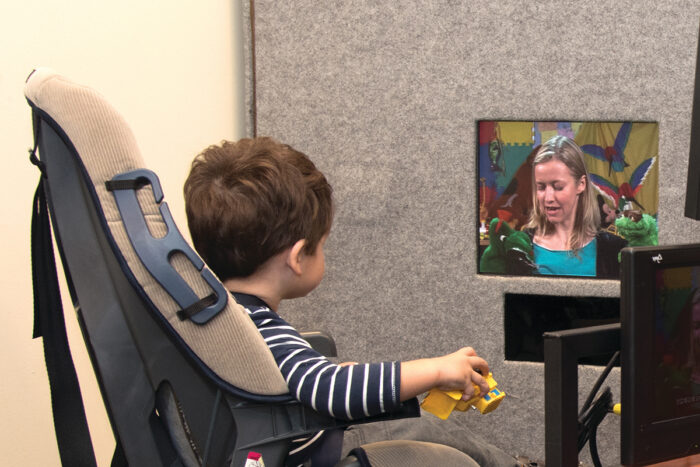Abnormal development of brain’s visual system may contribute to autism
MRI scans of babies identify irregularities
 Washington University School of Medicine
Washington University School of MedicineAs a child looks at pictures on a screen, computers track eye movements to see what the child is actually focused on. Children with autism spectrum disorder focus less often on people's faces than children without the disorder. A new study, led by researchers at Washington University School of Medicine in St. Louis and the University of North Carolina School of Medicine, has identified abnormalities in the development of the brain’s visual system in infants that may predispose them to developing autism.
A research team, led by Washington University School of Medicine in St. Louis and the University of North Carolina (UNC) School of Medicine, has identified abnormalities in the development of the brain’s visual system in infants that may predispose them to developing autism.
The research, published May 26 in the American Journal of Psychiatry, suggests that irregularities in the brain’s visual system may alter the way that some babies experience their surroundings and interact with others, thus further affecting brain development and potentially contributing to autism spectrum disorder.
The researchers conducted MRI brain scans on 384 babies at high risk of autism because they have older siblings with autism spectrum disorder. Indeed, almost 25% of the infants in the study went on to be diagnosed with autism. Their brain scans revealed abnormalities in the size, white matter and functional connectivity of the babies’ visual systems, and such irregularities were present long before any symptoms of autism were detectable.
“These abnormalities in the brain’s visual structures track very nicely with our earlier research into the eye movements of children with autism,” said John N. Constantino, MD, one of the study’s senior authors, the Blanche F. Ittleson Professor of Psychiatry and Pediatrics and director of the Division of Child & Adolescent Psychiatry at Washington University. “In past research, we’ve noted that children with autism often look less at people’s faces than children without the disorder. In this study, we’ve seen that abnormal development of the visual system may be rooted in genetics because the extent of alterations in the visual systems in children as young as 6 months old was associated with the severity of autism traits in their older siblings.”
The research was conducted as part of the Infant Brain Imaging Study (IBIS), funded by the National Institutes of Health (NIH) and involving researchers at nine universities in the United States and Canada.
The children in the study were scanned at 6, 12 and 24 months of age, and 89 of those babies went on to develop autism themselves. That’s almost a 1-4 chance, significantly higher than the 1 in 54 children currently affected by autism spectrum disorder in the United States.
The researchers measured brain volume and surface area in the occipital cortex, a brain region involved in vision. They also examined white matter in a part of the brain previously linked to how infants track visual stimuli in the environment. In addition, the researchers documented the autistic traits in older siblings.
They found that in 6-month-olds who went on to develop autism by their second birthdays, brain features related to the structure and function of the visual system were different from infants who didn’t develop autism.
“It is particularly notable that we were able to demonstrate associations between brain findings in these infants and the behavior of their older siblings with autism,” said co-senior author John R. Pruett Jr., MD, PhD, a professor of psychiatry at Washington University. “The convergence of brainwide fcMRI results with structural and diffusion MRI findings strengthens our confidence in these discoveries, which now can be tested in a new group of 250 infants being recruited for another study because they have affected siblings and are at very high likelihood.”
The research was led by Jessica Girault, PhD, an assistant professor of psychiatry at the UNC School of Medicine. She previously had found that younger siblings of children with autism were more likely to develop the disorder if their older siblings had more autistic traits, such as repetitive behaviors, delayed language, avoiding eye contact and social impairment.
“Those past findings suggested that the presence of these autistic traits could tell us something about the strength of the genetic factors for autism within a family,” said Girault, who also is a member of the Carolina Institute of Developmental Disabilities. “But we couldn’t say much beyond that. The current study takes our work a step forward as we begin to parse differences in infant brain development that might be related to those genetic factors.”
When parents and babies bond, they tend to lock eyes in a developmental process that gives infants a way to learn to interpret subtle visual cues in the environment. The process partly determines how babies learn to relate a caregiver’s behaviors to their own. That visual rhythm through the first years of life is critical to babies’ cognitive, emotional and social development. The new research suggests something goes wrong in the brain’s visual system, affecting this visual interplay in the babies who go on to develop autism.
Co-senior author Joseph Piven, MD, a professor of psychiatry, pediatrics and psychology at UNC and director of the Carolina Institute of Developmental Disabilities, said he believes aberrant visual circuitry may be a fundamental cog in the cascade of events leading to later autism.
The researchers say more studies are needed, but they agree this new study points to the possibility of using behavioral interventions aimed at the visual system in an attempt to decrease the likelihood that children will go on to develop some of the more severe traits associated with autism spectrum disorder.






